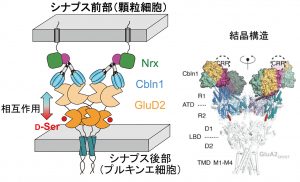Published in Science,en
A new paper, based on collaboration with Dr. Arisesuku's lab at Oxford University, 7has been published in Science on July 15th..。In this research、It is a joint of nerve cells and nerve cells to reveal the structure of the bridge that connects the "synapse"、Nerve cells in conjunction with each other was to elucidate the new mechanisms regulating neural network function。The results of this research”It was featured in the "This week in Science“But it was introduced as "Transmitting signals across the synapse (signal beyond the synapse)."。
 In the synapse、Glutamate is released from presynaptic、Excitement to the next nerve cell is transmitted by binding to the glutamate receptor of postsynaptic。Furthermore, from presynaptic、It has been revealed in our laboratory that the group of molecules similar to "complement" of the immune system be released to adjust the synaptic function so far。However、And excitement transmission path through the glutamic acid、How to work and how synaptic regulatory pathways by complement family molecules did not know well。
In the synapse、Glutamate is released from presynaptic、Excitement to the next nerve cell is transmitted by binding to the glutamate receptor of postsynaptic。Furthermore, from presynaptic、It has been revealed in our laboratory that the group of molecules similar to "complement" of the immune system be released to adjust the synaptic function so far。However、And excitement transmission path through the glutamic acid、How to work and how synaptic regulatory pathways by complement family molecules did not know well。
In small brain circuit、Presynaptic releases complement family molecules referred to as CB El N. 1 (Cbln1)、And then binds to a receptor that neurexins (Nrx) present in the presynaptic。On the other hand、Cbln1 will cause the synapse formed by combining at the same time also to the postsynaptic delta type 2 glutamate receptor (GluD2)。Nozawa-kun, together with Hayashi-san、Nrx-Cbln1-GluD2 the structure of the three-party complex that was the first time Tokiakasa。as a result、Cbln1 not only serve to anchor the presynaptic and postsynaptic as adhesive、By adjusting the working styles itself postsynaptic GluD2 the subtle、It was found to control the happened ease of excitement transmission in the synapse (= memory and learning process)。
Complement family molecules · Nrx · glutamate receptors are also present in various brain regions other than the cerebellum。Therefore、This was revealed、Functional regulation mechanism of glutamate receptors by complement family molecules are expected to be working as well in a variety of neural circuits。
07/15/2016 10:09 AM | What's New